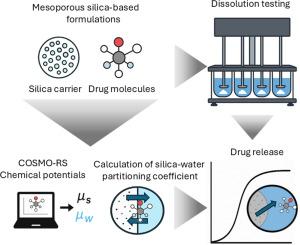Approaching drug release performance from mesoporous silica formulations by modeling of chemical potentials
IF 4.7
3区 医学
Q1 PHARMACOLOGY & PHARMACY
引用次数: 0
Abstract
Mesoporous silica are promising bio-enabling carriers for poorly soluble drugs. However, a comprehensive understanding of drug-silica interactions and their impact on drug release remains limited. Apart from urgently needed experimental tools, predictive in silico tools that consider drug-carrier interactions in aqueous media are currently lacking. To address this gap, a novel in silico approach (silica-water partitioning coefficient) was introduced in this study. A series of ten drugs were loaded onto a mesoporous carrier (Parteck® SLC 500), and the products were analyzed using differential scanning calorimetry (DSC) and X-ray powder diffraction (XRPD). In vitro dissolution (USP II) profiles of drug-loaded formulations were analyzed and correlated with a newly introduced silica-water partitioning coefficient derived from chemical potential calculations using the Conductor-like Screening Model for Real Solvents (COSMO-RS). Strong correlations were observed between dissolution parameters, such as the initial release slopes (Pearson r = -0.98; p = < 0.05) and AUC values (Pearson r = -0.79; p < 0.05), and the calculated chemical potential-based partitioning coefficient. This study introduces a predictive method based on COSMO-RS-derived chemical potentials to estimate silica-water partitioning for drugs, thereby predicting their release performance from mesoporous silica formulations. The results demonstrate that these calculated chemical potentials can qualitatively rank the drug release kinetics in aqueous media. Further investigation with additional compounds and carrier types may broaden the applicability of this approach as a mechanistic tool for mesoporous silica formulation development and contribute to narrowing the gap toward future clinical translation.

通过模拟化学势来研究介孔二氧化硅制剂的药物释放性能。
介孔二氧化硅是一种很有前途的难溶性药物载体。然而,对药物-二氧化硅相互作用及其对药物释放的影响的全面了解仍然有限。除了急需的实验工具外,目前还缺乏考虑水介质中药物载体相互作用的预测性硅工具。为了解决这一差距,本研究引入了一种新颖的硅方法(硅-水分配系数)。将10种药物(n = 10)装载到介孔载体(Parteck®SLC 500)上,用差示扫描量热法(DSC)和x射线粉末衍射(XRPD)对产物进行分析。本文分析了载药制剂的体外溶出度(USP II),并将其与新引入的二氧化硅-水分配系数进行了关联,该系数是通过使用真实溶剂类导体筛选模型(cosmos - rs)的化学势计算得出的。溶出参数如初始释放斜率(Pearson r = -0.98;p = < 0.05)与AUC值(Pearson r = -0.79;p
本文章由计算机程序翻译,如有差异,请以英文原文为准。
求助全文
约1分钟内获得全文
求助全文
来源期刊
CiteScore
9.60
自引率
2.20%
发文量
248
审稿时长
50 days
期刊介绍:
The journal publishes research articles, review articles and scientific commentaries on all aspects of the pharmaceutical sciences with emphasis on conceptual novelty and scientific quality. The Editors welcome articles in this multidisciplinary field, with a focus on topics relevant for drug discovery and development.
More specifically, the Journal publishes reports on medicinal chemistry, pharmacology, drug absorption and metabolism, pharmacokinetics and pharmacodynamics, pharmaceutical and biomedical analysis, drug delivery (including gene delivery), drug targeting, pharmaceutical technology, pharmaceutical biotechnology and clinical drug evaluation. The journal will typically not give priority to manuscripts focusing primarily on organic synthesis, natural products, adaptation of analytical approaches, or discussions pertaining to drug policy making.
Scientific commentaries and review articles are generally by invitation only or by consent of the Editors. Proceedings of scientific meetings may be published as special issues or supplements to the Journal.

 求助内容:
求助内容: 应助结果提醒方式:
应助结果提醒方式:


